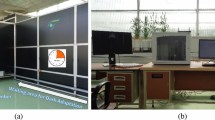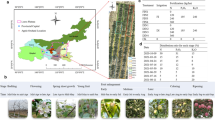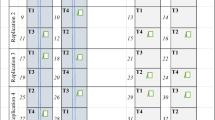Abstract
Lack of water resources and high water salinity levels are among the most important growth-restricting factors for plants species of the world. This research investigates the effect of irrigation levels and salinity on reflectance of Saint John’s wort leaves (Hypericum perforatum L.) under stress conditions (water and salt stress) by multiple linear regression (MLR), artificial neural network (ANN) and adaptive neuro-fuzzy inference system (ANFIS). Empirical and heuristics modeling methods were employed in this study to relate stress conditions to leaf reflectance. It was found that the constructed ANN model exhibited a high performance than multiple regression and ANFIS in estimating leaf reflectance accurately.
Similar content being viewed by others
References
Kirakosyan A., Gibson D., Sirvent T., Comparative survey of Hypericum perforatumplants as sources of hypericins and hyperforin, Journal of Herbs Species and Medicinal Plants, 2003, 10, 110–122
Cirak C., Saglam B., Ayan A.K., Kevseroglu K., Morphogenetic and diurnal variation of hypericin in some Hypericum species from Turkey during the course of ontogenesis, Biochemical Systematics and Ecology, 2006, 34, 1–13
Cirak C., Radusiene J., Janulis V., Ivanauskas L., Chemical constituents of some Hypericum species growing in Turkey, Journal of Plant Biology, 2007a, 50(6), 632–635
Patocka J., The chemistry pharmacology and toxicology of the biologically active constituents of the herb Hypericum perforatum L., Journal of Applied Biomedicine, 2003, 1, 61–73
Cirak C., Radusiene J., Saglam B., Janulis V., Variation of bioactive substances and morphological traits in Hypericum perforatum populations from Northern Turkey, Biochemical Systematics and Ecology, 2007b, 35, 403–409
Cirak C., Bertolli A., Pistelli L., Seyis F., Essential oil composition and variability of Hypericum perforatum from wild populations of northern Turkey, Pharmaceutical Biology, 2010, 48(8), 906–914
Vlietinck A.J., De Beuyne T., Apers S., Pieters L., Plant derived leading compounds for chemotherapy of human immunodeficiency virus (HIV) infection, Planta Medica, 1998, 64, 97–109
Cirak C., Radusiene J., Stanius Z., Camas N., Caliskan O., Odabas M.S., Secondary metabolites of Hypericum orientale L. growing in Turkey: variation among populations and plant parts, Acta Physiologia Plantarum, 2012, 34, 1313–1320
Cirak C., Radusiene J., Camas N., Caliskan O., Odabas M.S., Changes in the contents of main secondary metabolites in two Turkish Hypericum species during plant development, Pharmaceutical Biology, 2013, 51(3), 391–399
Shao H.B., Chu L.Y., Jaleel C.A., Water-deficiet stress-induced anatomical changes in higher plants, C. R. Biologies, 2008, 331(3), 215–225
Copeman R.H., Martin C.A., Stutz J.C., Tomato growth in response to salinity and mycorrhizal fungi from saline or non-saline soils, Hortscience, 1996, 31(3), 341–344
Yildirim E., Taylor A.G., Effect of biological treatments on growth of bean plants under salt stress, Annual Report of the Bean Improvement Cooperative, 2005, 48, 176–177
Flowers T.J., Flowers S.A., Why does salinity pose such a difficult problem for plant breeders? Agricultural Water Management, 2005, 78, 15–24
Page A.L., Chang A.C., Adriano D.C., Agricultural salinity assessment stresses and management deficiencies and toxicities of trace elements, in: tanj, K.K. (Eds), Manuals and Reports on Eng. Practice, 1990, 71, 138–160
Said-Al Ahl H.A.H., Meawad A.A., Abou-Zeid E.N., Ali M.S., Response of different basil varieties to soil salinity, Int. Agrophysics, 2010, 24, 183–188
Kara B., Kara N., Effect of different salinity (NaCl) concentrations on the first development stages of root and shoot organs of wheat, Anadolu J. Agric. Sci., 2010, 25(1), 37–43
Erper I., Turkkan M., Odabas M.S., The mathematical approach to the effect of potassium bicarbonate on mycelial growth of Sclerotinia sclerotiorum and Rhizoctonia solani in vitro, Zemdirbyste=Agriculture, 2011, 98(2), 195–204
Bekat T., Erdogan M., Inal F., Genc A., Prediction of the bottom ash formed in a coal-fired power plant using artificial neural networks, Energy, 2012, 45, 882–887
Yilmaz I., Kaynar O., Multiple regression, ANN (RBF, MLP) and ANFIS models for prediction of swell potential of clayey soils, Expert Systems with Applications, 2011, 38, 5958–5966
Xing-Mei S., Ying-Tao J., Mei Y., Shao-Kun L., Ke-Rum W., Chong-Tao W., Artificial Neural Network to Predict Leaf Population Chlorophyll Content from Cotton Plant Images, Agric. Sci. in China, 2010, 9(1), 38–45
Arfken G., The Method of Steepest Descents, In: Mathematical Methods for Physicists, 3rd (ed.): Academic Press (Orlando, USA), 1985, 428–436
Wilamowski B.M., Chen Y., Malinowski A., Efficient algorithm for training neural networks with one hidden layer, In Neural Networks, IJCNN’ 99 International Joint Conference USA, 1999, 35–45
Hagan M.T., Menhaj M.B., Training feedforward networks with the marquardt algorithm, IEEE Transactions on Neural Networks, 1945, (6), 989–993
Jang J.S., ANFIS: adaptive-network-based fuzzy inference system, IEEE Trans. Sys. Man. Cybern, 1993, 23(3), 665–685
Yoneyama Y., Nonlinear control design based on generalized Takagi-Sugeno fuzzy systems, Journal of the Franklin Institute, 2013, 25–27
Jang J.S., Sun C.T., Mizutani E., Neuro-Fuzzy and Soft Computing: A Computational Approach to Learning and Machine Intelligence, Upper Saddle River NJ: Prentice-Hall, 1997, 5–15
Basheer I., Selection of methodology for modeling hyster esis behavior of soils using neural networks. J. Comput.-aided Civil Infrastruct. Eng, 2000, 5(6), 445–463
Paliwal M., Kumar U.A., Neural networks and statistical techniques: A review of applications, Expert systems with applications, 2009, 36, 2–17
Tokar A.S., Johnson P.A., Rainfall-runoff modelling using artificial neural networks. Journal of Hydrologic Engineering, ASCE, 1999, 4(3), 232–239
Tayfur G., Guldal V., Artificial neural networks for estimating daily total suspended sediment in natural streams, Nordic Hydrology, 2006, 37, 69–79
Lenard M.J., Alam P., Madey G.R., The application of neural networks and a qualitative response model to the auditor’s going concern uncertainty decision, Decision Sciences, 1995, 26(2), 209–227
Reggia J.A., Neural computation in medicine. Artificial Intelligence Medicine, 1993, 5, 143–157
Ottenbacher K.J., Smith P.M., Illig S.B., Linn R.T., Fiedler R.C., Granger C.V., Comparison of logistic regression and neural networks to predict rehospitalization in patients with stroke, Journal of Clinical Epidemiology, 2001, 54(11), 1159–1165
Feng C.X., Wang X., Digitizing uncertainty modeling for reverse engineering applications: Regression versus neural networks. Journal of Intelligent Manufacturing, 2002, 13(3), 189–199
Yesilnacar E., Topal T., Landslide susceptibility mapping: A comparison of logistic regression and neural networks methods in a medium scale study, Hendek region, Turkey, Engineering Geology, 2005, 79(3–4), 251–266
Fish K.E., Barnes J.H., Aiken M.W., Artificial neural networks: A new methodology for industrial market segmentation, Industrial Marketing Management, 1995, 24, 431–438
Ainscough T.L., Aronson J.E., An empirical investigation and comparison of neural networks and regression for scanner data analysis, Journal of Retailing and Consumer Services, 1999, 6(4), 205–217
Ayoubi S., Sahrawat K.L., Comparing multivariate regression and artificial neural network to predict barley production from soil characteristics in northern Iran, Archives of Agronomy and Soil Science, 2011, 57(5), 549–565
Author information
Authors and Affiliations
Corresponding author
About this article
Cite this article
Temizel, K.E., Odabas, M.S., Senyer, N. et al. Comparision of some models for estimation of reflectance of hypericum leaves under stress conditions. cent.eur.j.biol. 9, 1226–1234 (2014). https://doi.org/10.2478/s11535-014-0356-4
Received:
Accepted:
Published:
Issue Date:
DOI: https://doi.org/10.2478/s11535-014-0356-4




